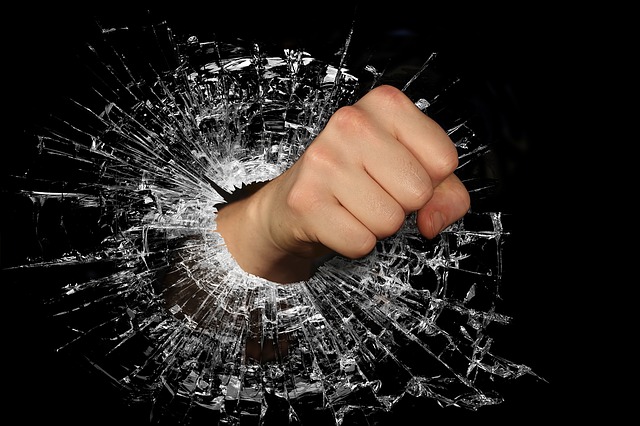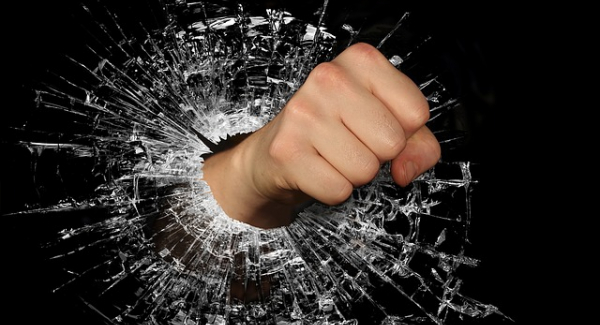
When angry, count ten before you speak; if very angry, a hundred.
—Thomas Jefferson
When angry count four; when very angry, swear.
— Mark Twain
Anger is an emotional response to a real or imagined threat or provocation. Anger can range in intensity from mild irritation to extreme rage. We all become angry, and most of us don’t like it. The question is how to get rid of anger, or at least reduce it. That is the topic of this article.
Emotions can be grouped along two dimensions: (1) unpleasant versus pleasant, and (2) high arousal versus low arousal (Russell, 1980). Anger falls in the unpleasant, high arousal category, because anger both feels bad and energizes people to take action. The tendency to take action, however, does not mean that angry people act wisely. In fact, studies of risk taking show that angry people often act foolishly, especially favoring high-risk, high-payoff behaviors that often backfire and produce disastrous results (Leith & Baumeister, 1996).
Angry people also are impulsive and fail to consider the potential consequences of their actions (Scarpa & Raine, 2000). No doubt Thomas Jefferson’s advice (quoted above) to count to ten or even a hundred before acting while angry is aimed at giving people time to reflect on the consequences of their actions and possibly avoid impulsive, destructive acts that will be regretted later. For example, angry people often spout off hurtful comments to loved ones that they cannot later retract. Angry people seem to act first, and think later. Indeed, in one study (Leith & Baumeister, 1996), angry participants were instructed to wait for about one minute and make a brief list of pros and cons before making a decision. This condition eliminated the pattern of self-defeating decisions that angry participants in other conditions had shown. Thus, some of the costly effects of anger on decision-making stem precisely from failure to consider all the possible outcomes of the available choices.
The energizing aspect of anger makes people feel strong and powerful (e.g., Lerner & Keltner, 2001). Thus, anger can be a powerful force in motivating people to stand up for what they believe is right. The American Revolution, the civil rights movement, the feminist movement, and other causes probably benefited from anger and the resultant willingness to take action. Anger can also motivate people to excel in sports and other domains in which it is beneficial to take a competitive stance. For example, cyclist Lance Armstrong, 7-time Tour de France winner, has written in several of his books that he often uses anger to fuel his performance.
For example, during the 2009 Tour de France, Armstrong won third place behind Alberto Contador (the winner) and Andy Schleck (who took second place). During the race, teammate Contador “disobeyed” team orders and attacked in the final kilometers on the climb of Andorre Arcalis at Stage 7 and quickly gapped Armstrong. Because they were on the same team, there was no reason for Contador to leave Armstrong in the dust. Armstrong became very angry at Contador, and almost got into a fistfight with him. Armstrong said, “I couldn’t dislike the guy any more.” And “I can’t wait for July (2010). I’m serious. I’m . . . man . . . I want to f------ . . . I want to beat him” (Strickland, 2010). Armstrong is not the only cyclist fueled by anger. In the 2010 Tour de France, just as Schleck was attacking Contador on a climb, the chain came off Schleck's bike. As he fixed it, Contador raced ahead, putting Schleck out of contention for first place. When asked about the incident, Schleck said: "In the same situation I would not have taken advantage," And " I'm really disappointed. My stomach is full of anger, and I want to take my revenge" (Yuan, 2010). Although Schleck and Armstrong were both fueled by anger against Contador, Contador still won the 2010 Tour de France (Schleck finished #2 and Armstrong finished #23).
After reviewing tapes of Lance Armstrong, Henk Aarts, a psychology professor at Utrecht University in the Netherlands said: “There's a picture of this guy near the finish line and you see anger in his face but you can also see this determination,” And “What's interesting is the facial expression of anger almost completely overlaps with the facial expression of determination” (Villarica, 2010).
These observations are consistent with recent research by Aarts and his colleagues (2010) showing that people want things more when they are angry. In this research, participants were shown images of objects such as pens and glasses on a computer screen while angry, fearful, or expressionless faces flashed in the corners of the screens outside of their awareness. Participants were asked how much they wanted the object onscreen. They also squeezed a handgrip as hard as they could if they wanted the object. The results showed that participants who saw the angry faces paired with the objects wanted the objects the most and squeezed the handgrip hardest, suggesting that they were willing to exert more effort to acquire the objects.
Although angry people are motivated to pursue good things, they will also stand up and fight for things that may be trivial or ill advised. Of course, the most extreme act of aggression is killing another human being. Statistics show that the overwhelming majority of murders committed in the United States are facilitated by unchecked anger (e.g., U.S. Federal Bureau of Investigation, 2010). Angry people may choose their battles poorly. Indeed, anger is widely assumed to be an important cause of aggression. In support of that view, nearly all experimental studies of aggression try to make participants angry first. For example, the studies on media violence and aggression typically find that watching violent films increases aggression only among participants who have been first angered (e.g., Berkowitz & Geen, 1967). Non-angry people who watch the same films typically exhibit much lower levels of aggression.
Perhaps that is not the whole story, however. One theory has held that anger actually evolved to reduce aggression rather than increase it. In this view, social conflicts lead to aggression as one way of deciding what animal gets what it wants. This gets the job done but in a costly manner, because aggression is harmful. Anger may have evolved as an advanced warning signal that aggression may be impending. This can allow the two disputants to settle the manner without coming to blows. To put this another way, if there were no anger, then whenever you had a conflict with someone, aggression could erupt without warning. In contrast, now that anger often comes first, you can tell when someone is getting close to attacking, and so you can suggest a compromise, give in, or even take flight before you get hurt (Averill, 1982).
Indeed, our own work has suggested that it is an oversimplification to say that aggression emerges from anger. Aggression may actually function as a rough form of anger management, insofar as people engage in aggression because they expect to get rid of their anger that way. Our studies borrowed the “mood-freezing pill” manipulation developed by Robert Cialdini and his colleagues in the 1980s. Some participants were given a pill and told (falsely) that it would temporarily render their emotional state immune to change. No matter how they felt, they would remain feeling that way for about an hour after taking the pill. We found that when people had taken this pill, anger did not lead to aggression (Bushman, Baumeister, & Phillips, 2003). Why? The mood-freezing pill ostensibly removes the possibility of regulating your emotion. Whatever people normally do to change their emotions becomes useless (or so they believe) after they take that pill. The implication is that angry people normally aggress because they expect aggression to remove their anger and make them feel better. After taking the mood-freezing pill, they believe they will not feel better if they aggress, and so they refrain from aggressing.
To be sure, the mood-freezing effects do not signify that the person is carefully deliberating among carefully considered options and anticipated outcomes when deciding whether to aggress. Rather, they suggest simply that people act in ways that seem to carry the promise of making oneself feel better. When that promise is removed (such as by the mood-freezing pill), the emotional appeal of aggression is diminished, and so people feel less inclined to lash out.
Because it is unpleasant, many people want to get rid of their anger when they experience it. There are three possible ways of dealing with anger. One standard approach endorsed by many societies is to hide one’s anger. This approach can prompt people to stuff their anger deep inside and repress it. There is some evidence that this is a costly strategy. Long-term concealed anger can be quite destructive to the person, increasing the risk of such illnesses as heart disease (e.g., Ellis, 1977). On the other hand, if people try to hide their anger, some anger might be diminished. According to the facial feedback hypothesis, feedback from the face muscles evokes or magnifies emotions (e.g., Tomkins, 1962; Izard, 1990). Thus, people who show their anger might feel angrier inside than people who hide their anger.
A second approach to deal with anger is to express it. This view treats anger as a kind of inner pressure or corrosive substance that builds up over time inside the person and does harm unless it is released. This view is commonly reflected in the metaphors of the English language (Lakoff & Kovecses, 1983). People are sometimes described as being like teapots or pressure cookers, and their anger is the fluid inside. As irritations increase, the anger inside builds up and rises. We talk about anger “welling up inside” people. When people become very angry, their “blood boils” or they reach the “boiling point.” If the anger becomes too intense, people “blow up,” blow their stack,” “blow a fuse,” “erupt,” “flip their lid,” “hit the ceiling,” or “go through the roof.” To prevent the explosion, people are encouraged to “vent their anger,” “blow off steam,” “let it out,” and “get it off their chest.”
Catharsis theory fits in this second approach because it holds that expressing anger produces a healthy release of emotion and is therefore good for the psyche. Catharsis theory, which can be traced back through Sigmund Freud to Aristotle, is elegant and appealing. Unfortunately, the facts and findings do not show that venting one’s anger has positive value. It harms the self and others. Expressing anger is linked to higher risk of heart disease (e.g., Miller, Smith, Turner, Guijarro, & Hallet, 1996). Expressing anger also increases aggression against others (Geen & Quanty, 1977). Even among people who believe in the value of venting and catharsis, and even when people enjoy their venting and feel some satisfaction from it, aggression becomes more likely after venting, even against innocent bystanders (Bushman, Baumeister, & Stack, 1999).
One variation of venting is intense physical exercise. When angry, some people go running or try some other form of physical exercise. Research shows that although exercise is good for your heart, it is not good for reducing anger (e.g., Bushman, 2002). The reason exercise doesn’t work is that it increases rather than decreases physiological arousal levels such as heart rate and blood pressure. (It is possible, however, that prolonged exercise will eventually reduce anger, if it continues until the person is extremely tired — because then the arousal is finally dispersed.)

There are exceptions to the general finding that expressing anger increases aggression. Recent research has shown that expressing anger can even reduce aggressive thoughts when people are trying to achieve a different goal (e.g., Denzler, Förster & Liberman, 2009). In general, however, venting anger is like using gasoline to put out a fire: It just feeds the flame. Venting keeps arousal levels high and keeps aggressive thoughts and angry feelings alive. Maybe you have heard of the joke, “How do you get to Carnegie Hall?” The answer is: “Practice! Practice! Practice!” Well, “How do you become an angry, aggressive person?” The answer is the same: “Practice! Practice! Practice!” Venting is just practicing how to behave more aggressively, by hitting, kicking, screaming, or shouting.
The third approach to deal with anger is to try to get rid of it. This solution is important because the problems of both the other approaches (i.e., stuffing and venting) are due to the person staying angry. The key thing is to stop feeling angry. All emotions, including anger, consist of bodily states (such as arousal) and mental meanings. To get rid of anger, you can work on either of those. Anger can be reduced by getting rid of the arousal state, such as by relaxing or by counting to ten before responding. Mental tactics can also reduce anger, such as by reframing the problem or conflict, or by distracting oneself and turning one’s attention to other, more pleasant topics. For example, rather than being angered by a friend’s rude comment, one might reinterpret the comment as a sign of the friend’s exhaustion rather than as a personal attack on oneself (e.g., Memedovic, Grisham, Denson, & Moulds, 2010). Certain behaviors can also help get rid of anger. For example, petting a puppy, watching a comedy, making love, or performing a good deed can help, because those acts are incompatible with anger and therefore they make the angry state impossible to sustain (e.g., Baron, 1976).
In summary, if a pressure cooker is used as a metaphor for anger, there are three ways to deal with the buildup of steam (DiGiuseppe, 1995). One way is to wait until the pressure cooker explodes. A second way is reduce the pressure by periodically siphoning off some of the steam. The third (and best) way is to lower the flame and reduce the heat!
References
Aarts, H., Ruys, K. I., Veling, H., Renes, R.A., J. H. B. de Groot, A. M. van Nunen, & Geertjes S. (2010). The art of anger: Reward context turns avoidance responses to anger-related objects into approach. Psychological Science, 21, 1406-1410.
Averill, J. (1982). Anger and aggression: An essay on emotion. New York: Springer-Verlag.
Baron, R. A. (1976). The reduction of human aggression: A field study of the influence of incompatible reactions. Journal of Applied Social Psychology, 6, 260–274.
Berkowitz, L., & Geen, R. G. (1967). Stimulus qualities of the target of aggression: A further study. Journal of Personality and Social Psychology, 5(3), 364-368.
Bushman, B. J. (2002). Does venting anger feed or extinguish the flame? Catharsis, rumination, distraction, anger, and aggressive responding. Personality and Social Psychology Bulletin, 28, 724–731.
Bushman, B. J., Baumeister, R. F., & Phillips, C. M. (2001). Do people aggress to improve their mood? Catharsis beliefs, affect regulation opportunity, and aggressive responding. Journal of Personality and Social Psychology, 81, 17-32.
Bushman, B. J., Baumeister, R. F., & Stack, A. D. (1999). Catharsis, aggression, and persuasive influence: Self-fulfilling or self-defeating prophecies? Journal of Personality and Social Psychology, 76, 367–376.
Carver, C. S., & Harmon-Jones, E. (2009). Anger is an approach-related affect: Evidence and implications. Psychological Bulletin, 135(2), 183–204.
Denzler, M., Förster, J., & Liberman, N. (2009). How goal-fulfillment decreases aggression. Journal of Experimental Social Psychology, 45, 90-100.
DiGiuseppe, R. (1995). Developing the therapeutic alliance with angry clients. In H. Kassinove (Ed.), Anger disorders: Definition, diagnosis, and treatment. Washington, DC: Taylor and Francis.
Ellis, A. (1977). How to live with—and without—anger. New York: Reader’s Digest Press.
Geen, R. G., & Quanty, M. B. (1977). The catharsis of aggression: An evaluation of a hypothesis. In L. Berkowitz (Ed.), Advances in experimental social psychology (Vol. 10, pp. 1–37). New York: Academic Press.
Izard, C. E (1990). The substrates and functions of emotion feelings: William James and current emotion theory. Personality and Social Psychology Bulletin, 16, 626–635.
Lakoff, G. & Kövecses, Z. (1983). The cognitive model of anger inherent in American English (pp. 195-221). In D. Holland & N. Quinn. (Eds.), Cultural models in language and thought. Cambridge. UK: Cambridge University Press.
Strickland, W. (2010, 29 June). Lance old, but he does have one big motivation: Armstrong is looking to avenge last year's Tour humiliation by Contador (2010). Downloaded 4 January 2011 from http://nbcsports.msnbc.com/id/37941073/ns/sports-tour_de_france/
Leith, K. P., & Baumeister, R. F. (1996). Why do bad moods increase self-defeating behavior? Emotion, risk tasking, and self-regulation. Journal of Personality and Social Psychology, 71, 1250–1267.
Lerner, J. S., & Keltner, D. (2001). Fear, anger, and risk. Journal of Personality and Social Psychology, 81, 146–159.
Memedovic, S., Grisham, J. R., Denson, T. F., Moulds, M. L. (2010). The effects of trait reappraisal and suppression on anger and blood pressure in response to provocation. Journal of Research in Personality, 44, 540–543
Miller, T. Q., Smith, T. W., Turner, C. W., Guijarro, M. L., & Hallet, A. J. (1996). A meta-analytic review of research on hostility and physical health. Psychological Bulletin, 119, 322–348.
Russell, J. A. (1980). A circumplex model of affect. Journal of Personality and Social Psychology, 39, 1161-1178.
Scarpa, A., & Raine, A. (2000). Violence associated with anger and impulsivity. In J. C. Borod (Ed.), The neuropsychology of emotion. New York: Oxford University Press.
Tomkins, S. S. (1962). Affect, imagery, consciousness: Vol. 1. The positive affects. New York: Springer.
Villarica, H. (2010, 15 December). The bright side of anger — It motivates others. Time Downloaded 4 January 2011 fromhttp://healthland.time.com/2010/12/15/the-bright-side-of-anger-%e2%80%94...
Yuan, J. (2010, 19 July) Today’s Tour Stage Leaves Contender With ‘Stomach Full of Anger’ Downloaded 4 January 2011 fromhttp://nymag.com/daily/sports/2010/07/todays_tour_stage_leaves_conte.html
U. S. Federal Bureau of Investigation. (2010). Uniform crime reports. Washington, DC: U. S. Government Printing Office.


